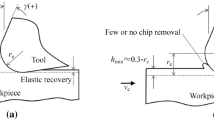Abstract
Molds for micro forming processes require specific functional surfaces to provide optimized tribological condition for forming processes. Such topographies with microscopic dimensions can for instance be generated by lithographical methods. However, a main disadvantage of these processes is their low flexibility, e.g. changing the structures to be generated causes extensive adaptations in the manufacturing process. Therefore, mechanical precision machining processes like micro milling, micro grinding and micro polishing are appropriate processes for the manufacture of micro molds of manifold shapes and with well suited micro topographies.



Similar content being viewed by others
References
Anon (1999) CVD diamond coated tools. Jahresbericht Fraunhofer-Institut für Schicht und Oberflächentechnik.
Brinksmeier E, Riemer O, Gessenharter A, Autschbach L (2004) Polishing of structured molds. Ann CIRP 53(1):247–250
Denkena B, Hoffmeister H-W, Reichstein M, Illenseer S (2003) Mikrozerspanung - Kolloquium Mikroproduktion. Schriftenreihe des Instituts für Werkzeugmaschinen und Fertigungstechnik der TU Braunschweig, Vulkan Verlag Essen, pp 65–74
Denkena B, Reichstein M, Hahmann D (2006) Electro contact discharge dressing for micro-grinding. Proceedings of the 6th euspen international conference, Wien, vol 2, pp 92–95
Denkena B, Reichstein M, Wang B (2006) Manufacturing of microfunctional structures by grinding. Proceedings of the 6th euspen international conference, Wien, vol 2, pp 224–227
Engel U, Neudecker T, Popp K (2000) 3D-Oberflächenanalyse–Methoden, Kenngrößen, Anwendungen. Matwiss u Werk WILEY 31:747–753
Evans C, Bryan J (1999) Structured, textured or engineered surfaces. Ann CIRP 48(2):541–556
Fleischer J, Schmidt J, Haupt S (2006) Efficient micromachining of hardened steels by using laser ablation and EDM. Proceedings of the 6th euspen international conference, vol 2, pp 96–99
Friedrich CR, Vasile MJ (1996) The micromilling process for high aspect ratio microstructures. J Microelectromech Syst 5(1):33–38
Hesselbach J, Raatz A (eds) 2002. MikroPRO—Untersuchung zum internationalen Stand der Mikroproduktionstechnik. Schriftenreihe des Instituts für Werkzeugmaschinen und Fertigungstechnik der TU Braunschweig. Vulkan Verlag Essen, pp 170–177
Hoffmeister H-W, Hlavac M (2006) Micro-milling of titanium- and nickel-base alloys. Proceedings of the 6th euspen international conference, vol 2, pp 124–127
Hwang D-H, zum Gahr K-H (2000) Einfluss der Oberflächenqualität auf das Einlaufverhalten ungeschmierter, mikrotribologischer Stahl/SiC-Gleitpaarungen im Vakuum. Mat.-wiss u Werkstoff WILEY 31:688–691. doi:10.1002/1521-4052(200008)31:8<688::AID-MAWE688>3.0.CO;2-H
Kahnis P, Weinert K (2006) Mikrofräsen von Stahl, Untersuchungen zu Frässtrategien zur Minimierung der Werkzeugauslenkung. euspen, 2:128
Kleiner M, Weinert K, Krux R, Kalveram M (2003) Einfluss spanend hergestellter Werkzeugoberflächenstrukturen auf die tribologischen Verhältnisse. wt-online 10:665
Klocke F, Brinksmeier E, Knodt S, Riemer O (2002) Skalierte Strukturen—Anwendungen und Herausforderungen für die Präzisions—und Mikrobearbeitung. VDI-Z 144(9/10):54–57
Kudla L (2006) Machining properties of microdrills with modified cutting part. Proceedings of the 6th euspen international conference, vol 2, pp 160–163
Moronuki N, Furukawa Y (2003) Frictional properties of the micro-textured surface of anisotropically etched silicon. Ann CIRP 52(1):471–474
Ohnishi O, Onikura H, Aziz M, Tsuruoka S, Min S-K, Koga T (2006) The effects of ultrasonic vibration on micro drilling performance with a diameter of 5 μm into titannium alloy. Proceedings of the 6th euspen international conference, vol 2, pp 20–23
Riemer O (2001) Trennmechanismen und Oberflächenfeingestalt bei der Mikrozerspanung kristalliner und amorpher Werkstoffe. Dissertation, Universität Bremen, Forschungsberichte aus der Stiftung Institut für Werkstofftechnik Bremen, Shaker-Verlag, Aachen, vol 7
Schauer K (2006) Entwicklung von Hartmetallwerkzeugen für die Mikrozerspanung mit definierter Schneide. Dissertation, TU Berlin, Berichte aus dem Produktionstechnischen Zentrum Berlin, Fraunhofer-IRB-Verl, Stuttgart, pp 26–29
Schmidt J, Tritschler H (2003) Mikrozerspanung. Kolloquium Mikroproduktion–Eine Kooperation der Sonderforschungsbereiche 440, 499 und 516. Schriftenreihe des Instituts für Werkzeugmaschinen und Fertigungstechnik der TU Braunschweig. Vulkan Verlag Essen, pp 183–191
Suh NP, Saka N (1987) Surface engineering. Ann CIRP 36(1):403–408
Suzuki H (2005) Micro milling of hard material with micro milling tool. euspen Montpellier, pp 577–580
Takeuchi Y (1997) Three-dimensional micromachining by means of ultraprecision milling. 9th Int. Precision Engineering Seminar, Braunschweig, pp 596–599
Tönshoff HK, Denkena B, Friemuth T, Reichstein M (2003) Precision grinding of components for aerostatic micro guidance. Institute of production engineering and machine tools, University of Hannover. Precis Eng 27:185–188. doi:10.1016/S0141-6359(02)00191-5
Uriarte L, Azcarate S, Santiso G, Albizuri J, Lopez de Lacalle LN (2006). Tool wear in micro-milling: experimental comparison of coatings. Proceedings of the 6th euspen International Conference, vol 2, pp 176–179
Weinert K, Kahnis P (2005) Untersuchung von Größeneinflüssen auf den Mikro-Fräsprozess. 2. SPP Kolloq 11:253–259
Wenda A (2002) Schleifen von Mikrostrukturen in sprödharten Werkstoffen. Dissertation TU Braunschweig, Vulkan Verlag Essen
Acknowledgments
The authors like to thank the German Research Foundation (Deutschen Forschungsgemeinschaft DFG) for funding within the Collaborative Research Centre 747 “Mikrokaltumformen” Bremen University.
Author information
Authors and Affiliations
Corresponding author
Rights and permissions
About this article
Cite this article
Brinksmeier, E., Gläbe, R., Riemer, O. et al. Potentials of precision machining processes for the manufacture of micro forming molds. Microsyst Technol 14, 1983–1987 (2008). https://doi.org/10.1007/s00542-008-0656-6
Received:
Accepted:
Published:
Issue Date:
DOI: https://doi.org/10.1007/s00542-008-0656-6




